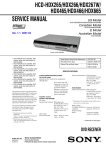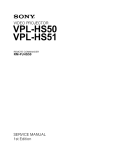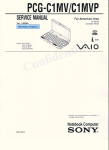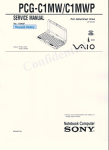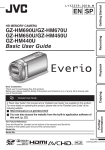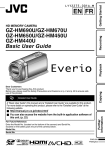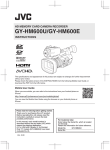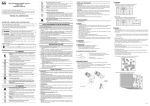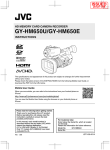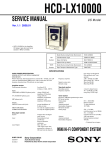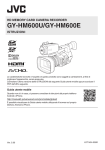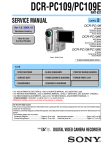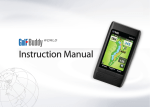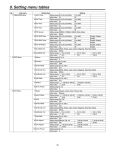Download SERVICE MANUAL
Transcript
SERVICE MANUAL HD MEMORY CARD CAMERA RECORDER SERVICE MANUAL 2 2013 HC047<Rev.001> GY-HM600U, GY-HM600E, GY-HM650U, GY-HM650E TIME CODE COPYRIGHT © 2013Note JVC: KENWOOD Corporation Lead free solder used in the board (material : Sn, Ag, In, Bi, melting point : 227 Centigrade) TABLE OF CONTENTS 1 2 3 4 5 PRECAUTION. . . . . . . . . . . . . . . . . . . . . . . . . . . . . . . . . . . . . . . . . . . . . . . . . . . . . . . . . . . . . . . . . . . . . . . . . 1-3 1.1 SAFETY PRECAUTIONS . . . . . . . . . . . . . . . . . . . . . . . . . . . . . . . . . . . . . . . . . . . . . . . . . . . . . . . . . . 1-3 SPECIFIC SERVICE INSTRUCTIONS . . . . . . . . . . . . . . . . . . . . . . . . . . . . . . . . . . . . . . . . . . . . . . . . . . . . . . 1-5 DISASSEMBLY . . . . . . . . . . . . . . . . . . . . . . . . . . . . . . . . . . . . . . . . . . . . . . . . . . . . . . . . . . . . . . . . . . . . . . . 1-5 3.1 Center frame section . . . . . . . . . . . . . . . . . . . . . . . . . . . . . . . . . . . . . . . . . . . . . . . . . . . . . . . . . . . . . . 1-5 3.2 L Side cover assembly section. . . . . . . . . . . . . . . . . . . . . . . . . . . . . . . . . . . . . . . . . . . . . . . . . . . . . . . 1-7 3.3 R Side cover assembly section . . . . . . . . . . . . . . . . . . . . . . . . . . . . . . . . . . . . . . . . . . . . . . . . . . . . . . 1-8 3.4 Handle assembly section . . . . . . . . . . . . . . . . . . . . . . . . . . . . . . . . . . . . . . . . . . . . . . . . . . . . . . . . . . . 1-8 ADJUSTMENT . . . . . . . . . . . . . . . . . . . . . . . . . . . . . . . . . . . . . . . . . . . . . . . . . . . . . . . . . . . . . . . . . . . . . . . 1-12 4.1 Instruments required for adjustment and the setup . . . . . . . . . . . . . . . . . . . . . . . . . . . . . . . . . . . . . . 1-12 4.2 Adjustment . . . . . . . . . . . . . . . . . . . . . . . . . . . . . . . . . . . . . . . . . . . . . . . . . . . . . . . . . . . . . . . . . . . . . 1-13 TROUBLE SHOOTING . . . . . . . . . . . . . . . . . . . . . . . . . . . . . . . . . . . . . . . . . . . . . . . . . . . . . . . . . . . . . . . . . 1-21 5.1 Service menus . . . . . . . . . . . . . . . . . . . . . . . . . . . . . . . . . . . . . . . . . . . . . . . . . . . . . . . . . . . . . . . . . . 1-21 5.2 How to update the firmware . . . . . . . . . . . . . . . . . . . . . . . . . . . . . . . . . . . . . . . . . . . . . . . . . . . . . . . . 1-24 COPYRIGHT © 2013 JVC KENWOOD Corporation No.HC047<Rev.001> 2013/2 SPECIFICATION GY-HM600U, GY-HM600E General Power GY-HM650U, GY-HM650E DC 12 V Power consumption Approx. 10.2 W Approx. 13.0 W (during recording with backlight set to [STANDARD] while the view- (during recording with backlight set to [STANDARD] while the viewfinder is in finder is in use) use) Mass Approx. 2.4 kg (with battery) Allowable operating temperature Allowable operating humidity 0 °C to 40 °C (32 °F to 104 °F) 30 %RH to 80 %RH Allowable storage temperature -20 °C to 50 °C (-4 °F to 122 °F) Approx. 2.5 kg (with battery) Terminal Section [HD/SD SDI] output terminal (480i or 576i:Downconverted 720p/1080i: embedded audio), BNC (unbalanced) HD-SDI SD-SDI [INPUT1/INPUT2] terminal Compliant with SMPTE 292 M Compliant with SMPTE 259 M [MIC] -50 dBu, 3 kΩ, XLR (balanced), +48 V output (phantom power supply) [LINE] +4 dBu, 10 kΩ, XLR (balanced) -22dBu, 10 kΩ, 3.5 mm stereo mini jack (unbalanced) [AUX] terminal [AV] terminal 4-pin 3.5 mm mini jack Video signal Audio signal 1.0 V (p-p) -8 dBu (during reference level input), 1 kΩ (unbalanced) [HEADPHONE] terminal 3.5 mm mini jack (stereo) x 1 [REMOTE] terminal [USB] terminal 2.5 mm wired remote control Ø2.5 mm mini jack (stereo) Mini USB-B type, USB 2.0, miniB, slave function (mass storage class) only [DEVICE] [HOST] - [IN] [OUT] 1.0 V(p-p) to 4.0 V(p-p) high impedance 2.0 ± 1.0 V(p-p) low impedance Mini USB-B type, USB 2.0, miniB, slave function (mass storage class) only USB-A type, USB2.0, network connection function only [TC] terminal Lens Section Lens Filter diameter Fujinon F1.6, 23x, f=4.1 mm to 94.3 mm (35 mm conversion: 29 mm to 667 mm) Ø72 mm Camera Section Image pickup device Color separation prism 1/3-inch Progressive CMOS F1.6, 3-color separation prism Sync system Internal sync (built-in SSG) Optical filter Gain OFF, 1/4, 1/16, 1/64 -6dB, -3dB, 0dB, 3dB, 6dB, 9dB, 12dB, 15dB, 18dB, 21dB, 24dB, Lolux (30dB, 36dB), ALC Electronic shutter 1/6 to 1/10000, EEI Variable frame Rate LCD monitor 2/30-60/30fps, 2/25-50/25fps, 2/24-60/24fps 3.5-inch LCD, 16:9 920K pixels Viewfinder 0.45-inch LCOS, 1.22 Mpixels (852 x 480 x 3) Storage Section Supported media Slots SDHC/SDXC x2 Video/Audio Recording time HD mode (MOV / MP4 / MXF: MPEG2) Approx. 25 minutes (8 GB SD card, 35 Mbps, VBR mode) Video recording file for- QuickTime File Format (For Final Cut Pro)/MP4 File Format QuickTime File Format (For Final Cut Pro)/MP4 File Format/ MXF File Format mat Video: HQ mode MPEG-2 Long GOP VBR, 35 Mbps (Max) MP@HL, 1920x1080/59.94i, 29.97p, 23.98p, 50i, 25p 1440x1080/59.94i, 50i 1280x720/59.94p, 29.97p, 23.98p, 50p, 25p Video: SP mode HD mode (AVCHD) MPEG-2 Long GOP CBR, 18.3 Mbps MP@HL (720p)/25 Mbps MP@H14 (1080i) 1440x1080/59.94i, 50i 1280x720/59.94p, 50p Video recording file for- AVCHD File Format mat Video: HQ mode MPEG-4 AVC/H.264, 24 Mbps (Max) 1920x1080/59.94i, 50i Video: SP mode Audio HD mode (MOV: H.264) MPEG-4 AVC/H.264, 17 Mbps 1920x1080/59.94i, 50i Dolby Digital 2ch, 48 kHz/16 Bit, 256 kbps Video recording file for- mat Video - MPEG-4 AVC/H.264, 35 Mbps (Max) 1920x1080/59.94i, 23.98p, 50i Audio LPCM 2ch, 48 kHz/16 Bit - QuickTime File Format SD mode (MOV: H.264) Video recording file for- QuickTime File Format mat Video Audio MPEG-4 AVC/H.264, 8 Mbps 720x480/59.94i (U model only), 720x576/50i (E model only) LPCM 2ch, 48 kHz/16 Bit Web mode (MOV: H.264) Video recording file for- mat QuickTime File Format Video - MPEG-4 AVC/H.264, 1.2 Mbps 480x270/29.97p, 23.98p, 25p Audio - µ-law 2ch, 16 kHz Accessories Warranty Card (U model only), Instructions, CDROM, AC Adapter, Power Cord (U model: 1, E model: 2), Battery, AV Cable, Clamp Filter, Wire Clamp, Large Eyecup 1-2 (No.HC047<Rev.001>) SECTION 1 PRECAUTION 1.1 SAFETY PRECAUTIONS Prior to shipment from the factory, JVC products are strictly inspected to conform with the recognized product safety and electrical codes of the countries in which they are to be sold.However,in order to maintain such compliance, it is equally important to implement the following precautions when a set is being serviced. 1.1.1 Precautions during Servicing (1) Locations requiring special caution are denoted by labels and inscriptions on the cabinet, chassis and certain parts of the product.When performing service, be sure to read and comply with these and other cautionary notices appearing in the operation and service manuals. (2) Parts identified by the symbol and shaded ( ) parts are critical for safety. Replace only with specified part numbers. NOTE : Parts in this category also include those specified to comply with X-ray emission standards for products using cathode ray tubes and those specified for compliance with various regulations regarding spurious radiation emission. (3) Fuse replacement caution notice. Caution for continued protection against fire hazard. Replace only with same type and rated fuse(s) as specified. (4) Use specified internal wiring. Note especially: • Wires covered with PVC tubing • Double insulated wires • High voltage leads (5) Use specified insulating materials for hazardous live parts. Note especially: • Insulation Tape • PVC tubing • Spacers • Insulation sheets for transistors • Barrier (6) When replacing AC primary side components (transformers, power cords, noise blocking capacitors, etc.) wrap ends of wires securely about the terminals before soldering. cathode ray tubes and other parts with only the specified parts. Under no circumstances attempt to modify these circuits.Unauthorized modification can increase the high voltage value and cause X-ray emission from the cathode ray tube. (12) Crimp type wire connector In such cases as when replacing the power transformer in sets where the connections between the power cord and power trans former primary lead wires are performed using crimp type connectors, if replacing the connectors is unavoidable, in order to prevent safety hazards, perform carefully and precisely according to the following steps. • Connector part number :E03830-001 • Required tool : Connector crimping tool of the proper type which will not damage insulated parts. • Replacement procedure a) Remove the old connector by cutting the wires at a point close to the connector.Important : Do not reuse a connector (discard it). cut close to connector Fig.1-1-3 b) Strip about 15 mm of the insulation from the ends of the wires. If the wires are stranded, twist the strands to avoid frayed conductors. 15 mm Fig.1-1-4 c) Align the lengths of the wires to be connected. Insert the wires fully into the connector. Metal sleeve Connector Fig.1-1-1 (7) Observe that wires do not contact heat producing parts (heatsinks, oxide metal film resistors, fusible resistors, etc.) (8) Check that replaced wires do not contact sharp edged or pointed parts. (9) When a power cord has been replaced, check that 10-15 kg of force in any direction will not loosen it. Power cord Fig.1-1-5 d) As shown in Fig.1-1-6, use the crimping tool to crimp the metal sleeve at the center position. Be sure to crimp fully to the complete closure of the tool. 1.2 5 2.0 5.5 Crimping tool Fig.1-1-6 e) Check the four points noted in Fig.1-1-7. Not easily pulled free Crimped at approx. center of metal sleeve Conductors extended Fig.1-1-2 (10) Also check areas surrounding repaired locations. (11) Products using cathode ray tubes (CRTs) In regard to such products, the cathode ray tubes themselves, the high voltage circuits, and related circuits are specified for compliance with recognized codes pertaining to X-ray emission. Consequently, when servicing these products, replace the Wire insulation recessed more than 4 mm Fig.1-1-7 (13) Battery replacement caution notice. CAUTION RISK OF EXPLOSION IF BATTERY IS REPLACED BY AN INCORRECT TYPE. DISPOSE OF USED BATTERIES ACCORDING TO THE INSTRUCTIONS. (No.HC047<Rev.001>)1-3 1.1.2 Safety Check after Servicing Examine the area surrounding the repaired location for damage or deterioration. Observe that screws, parts and wires have been returned to original positions, Afterwards, perform the following tests and confirm the specified values in order to verify compliance with safety standards. (1) Insulation resistance test Confirm the specified insulation resistance or greater between power cord plug prongs and externally exposed parts of the set (RF terminals, antenna terminals, video and audio input and output terminals, microphone jacks, earphone jacks, etc.).See table 1 below. (2) Dielectric strength test Confirm specified dielectric strength or greater between power cord plug prongs and exposed accessible parts of the set (RF terminals, antenna terminals, video and audio input and output terminals, microphone jacks, earphone jacks, etc.). See Fig.1-1-11 below. (3) Clearance distance When replacing primary circuit components, confirm specified clearance distance (d), (d') between soldered terminals, and between terminals and surrounding metallic parts. See Fig.1-1-11 below. (4) Leakage current test Confirm specified or lower leakage current between earth ground/power cord plug prongs and externally exposed accessible parts (RF terminals, antenna terminals, video and audio input and output terminals, microphone jacks, earphone jacks, etc.). Measuring Method : (Power ON) Insert load Z between earth ground/power cord plug prongs and externally exposed accessible parts. Use an AC voltmeter to measure across both terminals of load Z. See Fig.1-1-9 and following Fig.1-1-12. a Externally exposed accessible part Z A b c V Fig.1-1-9 (5) Grounding (Class 1 model only) Confirm specified or lower grounding impedance between earth pin in AC inlet and externally exposed accessible parts (Video in, Video out, Audio in, Audio out or Fixing screw etc.).Measuring Method: Connect milli ohm meter between earth pin in AC inlet and exposed accessible parts. See Fig.1-1-10 and grounding specifications. d d' Chassis Power cord primary wire Exposed accessible part AC inlet Fig.1-1-8 Earth pin Milli ohm meter Grounding Specifications Region Grounding Impedance ( Z ) USA & Canada Z 0.1 ohm Europe & Australia Z 0.5 ohm Fig.1-1-10 AC Line Voltage 100 V 100 to 240 V Region Insulation Resistance (R) Japan 110 to 130 V USA & Canada 110 to 130 V 200 to 240 V Europe & Australia R 1M 1 M /500 V DC R R 12 M /500 V DC 10 M /500 V DC Dielectric Strength AC 1 kV 1 minute AC 1.5 kV 1 minute Clearance Distance (d), (d') d, d ' 3 mm d, d ' 4 mm AC 1 kV 1 minute AC 3 kV 1 minute (Class ) AC 1.5 kV 1 minute (Class ) d, d' 3.2 mm d 4 mm d' 8 m m (Power cord) d' 6 m m (Primary wire) Leakage Current (i) a, b, c Fig.1-1-11 AC Line Voltage 100 V Japan 110 to 130 V USA & Canada 110 to 130 V 220 to 240 V Load Z Region Europe & Australia i 1 mA rms Exposed accessible parts i 0.5 mA rms Exposed accessible parts 2 i i 0.7 mA peak 2 mA dc Antenna earth terminals 50 i i 0.7 mA peak 2 mA dc Other terminals 1 0.15 1.5 Fig.1-1-12 NOTE : These tables are unofficial and for reference only. Be sure to confirm the precise values for your particular country and locality. 1-4 (No.HC047<Rev.001>) SECTION 2 SPECIFIC SERVICE INSTRUCTIONS This service manual does not describe SPECIFIC SERVICE INSTRUCTIONS. SECTION 3 DISASSEMBLY 3.1 Center frame section 3.1.1 Removing the L side cover assembly (See Figure 1, 2, 3 and 4) (1) Remove the four screws A attaching the L side cover assembly, and then open the L side cover assembly. A (3) Pull out the wire from the SDI terminal. (4) Pull out the wire from the connector CN3112 on the NETWORK board, and then remove the L side cover assembly (only GY-HM650). CN3112 A L Side cover assembly Fig.1 A A L Side cover assembly SDI Terminal Fig.4 L Side cover assembly 3.1.2 Removing the R side cover assembly (See Figure 5, 6, 7 and 8) • Remove the L side cover assembly. (1) Remove the four screws B and the one screw C attaching the R side cover assembly. Screw B: Short Screw C: Long (2) Remove the two screws D attaching the handle cover (R) and then remove the handle cover (R). Fig.2 (2) Pull out the wire from the connector CN210 on the MAIN board. CN210 MAIN Board B R Side cover assembly B Fig.5 R Side cover assembly B B L Side cover assembly Fig.3 Fig.6 (No.HC047<Rev.001>)1-5 (2) Pull out the wires from the connectors CN203, CN201, CN207, CN214, CN208, CN213, CN209, CN212, CN202, CN204, CN205, CN206, CN215 and CN216 on the MAIN board. (3) Remove the one screw F attaching the MAIN board, and then remove the MAIN board. (4) Remove the two screws G, and then remove the NETWORK board (only GY-HM650). D Handle cover (R) D CN214 CN208 CN207 CN215 CN201 C CN203 H G CN216 MAIN Board Fig.7 (3) Pull out the FFC wire from the connector CN1412 on the GAIN board, and then remove the R side cover assembly. CN213 GAIN Board CN1412 CN209 CN202 CN212 CN204 G CN206 CN205 Fig.10 3.1.4 Removing the SDSLOT board (See Figure 11) • Remove the R side cover assembly. (1) Pull out the wire from the connector CN809 on the SDSLOT board. (2) Remove the two screws H attaching the SDSLOT board, and then remove the SDSLOT board. H CN809 R Side cover assembly Fig.8 3.1.3 Removing the MAIN board and NETWORK board (See Figure 9 and 10) • Remove the L side cover assembly. (1) Remove the three screws E attaching the bracket (DCIN) and heat sink plate, and then remove the bracket (DCIN) and heat sink plate. • When attaching the bracket (DCIN) and heat sink plate, a bracket (DCIN) is under a heat sink plate. E Bracket (DCIN) H Fig.11 3.1.5 Removing the rear assembly (See Figure 12 and 13) • Remove the L side cover assembly and R side cover assembly etc, . (1) Remove the one screw J and the five screws K attaching the rear assembly, and then remove the rear assembly. Screw J: Silver Screw K: Black Heat sink plate E Rear assembly E Fig.9 J Fig.12 1-6 (No.HC047<Rev.001>) SDSLOT Board 3.1.7 Removing the lens unit (See Figure 16 and 17) • Remove the L side cover assembly and R side cover assembly etc, . (1) Remove the five screws M attaching the board bracket, and then remove the board bracket. K Board bracket M Rear assembly M K M M Fig.13 Fig.16 3.1.6 Removing the handle assembly (See Figure 14 and 15) • Remove the L side cover assembly and R side cover assembly etc, . (1) Remove the four screws L attaching the handle assembly, and then remove the handle assembly. • When attaching the handle assembly, let two wires from VF pass to the slit of a frame. (2) Remove the five screws N attaching the lens unit, and then remove the lens unit. N Handle assembly N Lens unit Fig.17 3.2 L L Side cover assembly section 3.2.1 Removing the Grip cover assembly (See Figure 1) (1) Remove the seven screws A attaching the grip cover assembly, and then remove the grip cover assembly. A L Fig.14 A Fig.1 Slit L Fig.15 (No.HC047<Rev.001>)1-7 3.2.2 Removing the TC board (See Figure 2) • Remove teh grip cover assembly. (1) Pull out the wires from the connectors CN1212, CN1211, CN1213 and CN1214 on the TC board. (2) Remove the two screws B attaching the TC board, and then remove the TC board. CN1213 CN1214 3.3.2 Removing the R OPE unit (See Figure 2) • Remove the GAIN board. (1) Remove the eight screws B attaching the R OPE unit, and then remove the R OPE unit. B CN1211 R OPE Unit B B B CN1212 B Fig.2 TC Board Fig.2 3.4 3.2.3 Removing the seesaw assembly (See Figure 3) • Remove the grip cover assembly and TC board. (1) Remove the two screws C attaching the seesaw assembly, and then remove the seesaw assembly. Handle assembly section 3.4.1 Removing the handle cover T (See Figure 1, 2 and 3) (1) Remove the one screw A attaching the shoe spring, and then remove the shoe spring. Seesaw assembly A C C Fig.3 3.3 Shoe spring Fig.1 R Side cover assembly section 3.3.1 Removing the GAIN board (See Figure 1) (1) Pull out the wire from the connector CN1413 on the GAIN board. (2) Remove the three screws A attaching the GAIN board, and then remove the GAIN board. (2) Remove the two screws B attaching the shoe, and then remove the shoe. (3) Remove the two screws C attaching the handle cover T. Shoe Handle cover T GAIN Board CN1413 C B Fig.2 A Fig.1 1-8 (No.HC047<Rev.001>) C (4) Pull out the FFC wire from the connector CN405 on the HANDLE board, and then remove the handle cover T. 3.4.3 Removing the VF unit (See Figure 7, 8 and 9) • Remove the handle cover T. (1) Remove the four screws F attaching the ACC base, and then remove the ACC base. F ACC Bace F Fig.7 (2) Remove the four screws G attaching the VF unit, and then remove the VF unit. CN405 VF Unit G HANDLE Board Fig.3 3.4.2 Removing the GPS and HANDLE board (See Figure 4, 5 and 6) • Remove the handle cover T. (1) Remove the one screw D attaching the GPS. (only GYHM650) Fig.8 D VF Unit GPS Fig.4 (2) Remove the three screws E attaching the bracket and HANDLE board. G G E Fig.9 HANDLE Board Fig.5 (3) Pull out the wire from the connector CN407 on the HANDLE board, and then remove the GPS and HANDLE board. 3.4.4 Removing the XLR board (See Figure 10, 11, 12 and 13) • Remove the handle cover T. (1) Remove the six screws H attaching the XLR cover. HANDLE Board XLR Cover H H CN407 Fig.10 Fig.6 (No.HC047<Rev.001>)1-9 (2) Remove the one screw L attaching the FFC, and then pull out the wire from the connector CN1806. (3) Remove the two screws M attaching the hinge, and then remove the monitor assembly. H M CN1806 M L Monitor assembly H Fig.11 (2) Pull out the wires from the connectors CN506 and CN503 on the XLR board. CN506 Fig.15 (4) Remove the one screw N, and then remove the front guard. (5) Remove the six screws P and the one screw Q attaching the OPE cover, and then remove the OPE cover. Front guard P P N P Q CN503 Fig.12 (3) Remove the four screws J attaching the terminal, and then remove the XLR board. AVR Board P P Fig.16 (6) Remove the two screws R attaching the volume knob, and then remove the volume knob. • When attaching the volume knob, turn in the direction of an arrow, and attach so that “0” becomes a position of a figure. R J Fig.13 3.4.5 Removing the monitor assembly and AVR board (See Figure 14, 15, 16, 17 and 18) (1) Remove the two screws K attaching the joint cover, and then remove the joint cover and hinge cover. K Joint cover Hinge cover K Fig.14 1-10 (No.HC047<Rev.001>) P "0" Fig.17 (7) Pull out the wires from the connectors CN301, CN305 and CN302 on the AVR board. (8) Remove the six screws S attaching the AVR board, and then remove the AVR board. S S CN305 CN302 CN301 S S AVR Board S S Fig.18 (No.HC047<Rev.001>)1-11 SECTION 4 ADJUSTMENT 4.1 Instruments required for adjustment and the setup 4.1.1 Measuring instruments required for adjustment Instrument Condition Instrument Condition PC (Windows) With an RS-232C compliant serial Audio tester communication port. Calibrated instrument. Color TV monitor Supporting HD(1080/60i), with an Speaker HDMI input. ---------- Oscilloscope 100 MHz or higher (300 MHz is recom- DC power source mended), calibrated instrument. 12V/1.7A or more, power source for light box. Signal generator Output level change is possible. AC adapter (1kHz, 300Hz) Used as a power source for the unit. (Accessory) Digital volt meter Calibrated instrument. Thermometer, Color thermometer, Illuminometer 4.1.2 Jigs and tools required for adjustment Adjustment software PC cable Focus chart QAM0099-002 YTU92001-018 Download from JS-NET HM6xx_Adjust.exe (.NET framework 4.0 required) Light source INF adjustment lens (Collimator) The halogen lamp of 3000K, YTU92001E 2600lx White chart 88.9% of reflectance 4.1.3 Set up for adjustment (1) Connect appropriate measuring instruments, jigs, and tools required for the adjustment item. Color TV monitor Oscilloscope 75 resistor for termination Video signal Focus chart Light source Collimator To AUX terminal PC Cable 1-12 (No.HC047<Rev.001>) 4.2 Adjustment The adjustment for this model is a special adjustment using a PC. Use the adjustment software (HM6xx_Adjust.exe) for adjustment. (1) Preparation of SD card for adjustment This camera can be changed to adjustment mode by using SD card for adjustment. The SD card for adjustment has a file named PROJECT.ADJ in a root directory. 4.2.1 Installation of adjustment software (1) Download adjustment software (HM6xx_Adjust.exe) from JS-NET, and store it in the arbitrary place in your PC. 4.2.2 The operation method (1) Connect PC cable (QAM0099-002) to PC and a camera (AUX terminal). (2) The screen as shown below will be displayed when launching the adjustment software. (3) Set up a serial port. (4) Operate the adjustment software by switching tabs according to the contents of adjustment. 4.2.2.1 ADJ Tab If ADJ tab is chosen, the tab according to the adjustment item will appear. (No.HC047<Rev.001>)1-13 (1) Composite tab This is used for Composite signal adjustment. By operating each slide bar, each value can be changed, and by pressing the [READ] button, the current preset value is acquirable. (2) ZOOM MR Tab This is used for Zoom ring adjustment. After pressing the [START] button, adjust by operating the Zoom ring, according to the instruction. • For FOCUS MR tab, ZOOM VR tab, and Z Tracking tab, adjust each article according to the instruction respectively. FOCUS MR tab for Focus ring adjustment, ZOOM VR tab for Zoom potentiometer adjustment, and Z Tracking tab for Zoom tracking adjustment. (3) OIS Drv tab This is used for OIS adjustment. After pressing the [START] button, adjust by rocking a camera, according to the instruction. 1-14 (No.HC047<Rev.001>) (4) Ingain tab This is used for Ingain adjustment. The adjustment is automatically performed when pressing the [START] button. (5) AF Filter tab This is used for AF Filter adjustment. The adjustment needs to be performed under the condition of ND 1/16 and ND 1/64. It is automatically performed under each condition when pressing each [START] button. (6) BPD Tab This is used for White Blemish adjustment. The adjustment is automatically performed when pressing the [START] button. (7) Audio tab This is used for audio adjustment. (No.HC047<Rev.001>)1-15 4.2.2.2 EEP Tab It is used when reading and writing the data of EEPROM which each microcomputer (CC, BE, IF) has managed. • For example, when reading the data of EEPROM which BE microcomputer has managed, input an address to read into the Adrs colummn on the left side of the [READ] button of BE Write, and press the [READ] button. • When writing data to EEPROM which BE microcomputer has managed, input an address to write into the Adrs column on the left side of the [Write] button of BE Write, and the data to write into the Data column, and then press the [Write] button. • Also for the EEPROM which CC microcomputer and IF microcomputer have managed, it is the same as that of BE microcomputer. 4.2.2.3 SETTING1 Tab and SETTING2 Tab This is used for setting parameters to the camera. Input a parameter to set to the camera into a relevant column, respectively, and then press the relevant [Write] button. 4.2.2.4 OTHERS Tab Each reset is assigned here and it is frequently-used. NOTE: Other tabs are not used. 1-16 (No.HC047<Rev.001>) 4.2.3 Preparation When the camera is in the adjustment mode, the red “P” letter can be seen at the top of the LCD screen, and this mode is retained until ALL Reset is performed with the adjustment software, even if shutting off the camera. (1) (2) (3) (4) (5) Insert the SD card for adjustment into slot B, and remove it after flashing slot B indicator. Connect a JLIP cable to an AUX terminal of the camera. When the clock setting screen of the camera is displayed, press the [SET] button of the camera to skip it. Choose an OTHERS tab, press the [0x01] button of the MENU Reset to reset the menu. In the case of the "U" model, Master Black is set to "-3". You need to set this to "0" for adjustment. the procedure is as follows; Choose EEP tab, input 7 into Adrs column of the BE Write, input 32 into Data column and then press the [Write] button. 4.2.4 Camera adjustment No. Adjustment Adjustment Jig item type Signal Adjustment standard Adjustment Adjustment Procedure point value range default value 1 Composite Manual ad- Oscillo- Built-in Composite analog out- justment scope color bar output put CGAIN 60Hz U 0.286V 0-255 112 (0x70) (1) Set Record Format to 1920 x 1080, 60i(HQ) or 1440 x 1080, 60i(HQ), if it has not been set so. Choose SETTING1 tab, input 0 into the "Video Format Change" column and then press the [Write] button. (2) Set SETUP to ON, if it has not been set so. Choose SETTING1 tab, input 1 into the "Composite Setup On/Off" column and then press the [Write] button. (3) Choose ADJ tab -> Composite tab, press the [Read] button of the CGAIN 60HZ U. (4) Adjust the value to the standard by operating the slider of the CGAIN 60HZ U, with observing the wave form on the oscilloscope. 2 Composite Manual ad- Oscillo- Built-in Composite analog out- justment scope color bar output put YGAIN 60Hz U 1.0V 0-255 162 (0xA2) (1) Set Record Format to 1920 x 1080, 60i(HQ) or 1440 x 1080, 60i(HQ), if it has not been set so. Choose SETTING1 tab, input 0 into the "Video Format Change" column and then press the [Write] button. (2) Set SETUP to ON, if it has not been set so. Choose SETTING1 tab, input 1 into the "Composite Setup On/Off" column and then press the [Write] button. (3) Choose ADJ tab -> Composite tab, press the [Read] button of the YGAIN 60HZ U. (4) Adjust the value to the standard by operating the slider of the YGAIN 60HZ U, with observing the wave form on the oscilloscope. 3 Composite Manual ad- Oscillo- Built-in Composite analog out- justment scope color bar output put YGAIN 60Hz I 1.0V 0-255 175 (0xAF) (1) Set Record Format to 1920 x 1080, 60i(HQ) or 1440 x 1080, 60i(HQ), if it has not been set so. Choose SETTING1 tab, input 0 into the "Video Format Change" column and then press the [Write] button. (2) Set SETUP to OFF, if it has not been set so. Choose SETTING1 tab, input 0 into the "Composite Setup On/Off" column and then press the [Write] button. (3) Choose ADJ tab -> Composite tab, press the [Read] button of the YGAIN 60HZ I. (4) Adjust the value to the standard by operating the slider of the YGAIN 60HZ I, with observing the wave form on the oscilloscope. (No.HC047<Rev.001>)1-17 No. Adjustment Adjustment Jig item type Signal Adjustment standard Adjustment Adjustment Procedure point value range default value 4 Composite Manual ad- Oscillo- Built-in Composite analog out- justment scope color bar output put CGAIN 50Hz E 0.30V 0-255 113 (0x71) (1) Set Record Format to 1920 x 1080, 50i(HQ) or 1440 x 1080, 50i(HQ), if it has not been set so. Choose SETTING1 tab, input 1 into the "Video Format Change" column and then press the [Write] button. (2) Choose ADJ tab -> Composite tab, press the [Read] button of the CGAIN 50HZ E. (3) Adjust the value to the standard by operating the slider of the CGAIN 50HZ E, with observing the wave form on the oscilloscope. 5 Composite Manual ad- Oscillo- Built-in Composite analog out- justment scope color bar output put YGAIN 50Hz E 1.0V 0-255 171 (0xAB) (1) Set Record Format to 1920 x 1080, 50i(HQ) or 1440 x 1080, 50i(HQ), if it has not been set so. Choose SETTING1 tab, input 1 into the "Video Format Change" column and then press the [Write] button. (2) Choose ADJ tab -> Composite tab, press the [Read] button of the YGAIN 50HZ E. (3) Adjust the value to the standard by operating the slider of the YGAIN 50HZ E, with observing the wave form on the oscilloscope. 6 ZOOM Ring Semiauto MR adjustment (Perform before "8. ZOOM Ring TELE/WIDE potentiometer" adjustment) - (1) Choose ADJ tab -> ZOOM MR tab, press the [START] button. (2) After pressing the [START] button, turn the ZOOM ring quickly clockwise and counterclockwise alternately by hand. (3) It will be completed when displayed as Complete. 7 FOCUS Semiauto Ring MR adjustment (Perform before "8. ZOOM Ring TELE/WIDE potentiometer" adjustment) - (1) Choose ADJ tab -> FOCUS MR tab, press the [START] button. (2) After pressing the [START] button, turn the FOCUS ring quickly clockwise and counterclockwise alternately by hand. (3) It will be completed when displayed as Complete. 8 ZOOM ring Semiauto TELE/WIDE adjustment potentiometer - (1) Set the ZOOM ring to the TELE end. (2) Choose ADJ tab -> ZOOM VR tab, press the [START] button. (3) After pressing the [START] button, turn the ZOOM ring slowly to the WIDE end by hand. (4) It will be completed when displayed as Complete. 9 ZOOM Tracking Automatic Colliadjustment mator LED lighting (1) Attach the Collimeter to the Lens. (2) Check the illumination is 19±3Lux. (3) Choose ADJ tab -> Z Tracking tab, press the [START] button. (4) It will be completed when displayed as Complete. 1-18 (No.HC047<Rev.001>) No. Adjustment Adjustment Jig item type 10 OIS Drive Automatic adjustment 11 INGAIN and Automatic ANALOGGAIN Mini adjustment studio 12 AF Filter ND Semiauto 1/16 Mini adjustment studio 13 AF Filter ND Semiauto 1/64 Mini adjustment studio 14 White blem- Automatic ish adjustment - Signal Adjustment standard Adjustment Adjustment Procedure point value range default value - (1) Choose ADJ tab -> OIS Drv tab, press the [START] button. (2) After pressing the [START] button, adjust so that the shake of a monitor screen comes to minimum, while vibrating a camera by hand. (3) It will be completed when displayed as Complete. White chart (1) Prepare an adjustment environment of 3000K (Mini studio or something). (2) Set Record Format to 1920 x 1080, 24p(HQ), if it has not been set so. Choose SETTING1 tab, input 4 into the "Video Format Change" column and then press the [Write] button. (3) Choose ADJ tab -> Ingain tab, press the [START] button. (4) It will be completed when displayed as Complete. White chart (1) Set ND filter to the 1/16 position. (2) Set Record Format to 1920 x 1080, 60i(HQ) or 1440 x 1080, 60i(HQ), if it has not been set so. Choose SETTING1 tab, input 0 into the "Video Format Change" column and then press the [Write] button. (3) Choose ADJ tab -> AF Filter tab, press the [START] button of ND 1/ 16. (4) It will be completed when displayed as Complete. White chart (1) Set ND filter to the 1/64 position. (2) Set Record Format to 1920 x 1080, 60i(HQ) or 1440 x 1080, 60i(HQ), if it has not been set so. Choose SETTING1 tab, input 0 into the "Video Format Change" column and then press the [Write] button. (3) Choose ADJ tab -> AF Filter tab, press the [START] button of ND 1/ 64. (4) It will be completed when displayed as Complete. - (IRIS CLOSE) (1) Wait about 30 minutes for pre-heating the camera. (2) Set Record Format to 1920 x 1080, 60i(HQ) or 1440 x 1080, 60i(HQ), if it has not been set so. Choose SETTING1 tab, input 0 into the "Video Format Change" column and then press the [Write] button. (3) Choose ADJ tab -> BPD tab, press the [START]. (4) It will be completed when displayed as Complete. (No.HC047<Rev.001>)1-19 4.2.5 Audio adjustment Perform this adjustment only when you change a microphone. No. Adjustment Adjustment Jig item type Signal 1 AUDIO XLR Manual adLevel justment INPUT1 LINE Level Audio signal generator 1kHz ADC DATA -20dBFS ±8 (+4dBu) (3277 as decimal value) (1) Switch XLR1 input to LINE. (2) Choose ADJ tab -> Audio tab, press the [Read] button of XLR LINE1 LEV. (3) Adjust by operating the slider so that the on-screen level meter indication comes to -20dB. 2 AUDIO XLR Manual adLevel justment INPUT1 MIC Level Audio signal generator 1kHz ADC DATA -20dBFS ±8 (-50dBu) (3277 as decimal value) (1) Switch XLR1 input to MIC. (2) Choose ADJ tab -> Audio tab, press the [Read] button of XLR MIC1 LEV. (3) Adjust by operating the slider so that the on-screen level meter indication comes to -20dB. 3 AUDIO XLR Manual adLevel justment INPUT2 LINE Level Audio signal generator 1kHz ADC DATA -20dBFS ±8 (+4dBu) (3277 as decimal value) (1) Switch XLR2 input to LINE. (2) Choose ADJ tab -> Audio tab, press the [Read] button of XLR LINE2 LEV. (3) Adjust by operating the slider so that the on-screen level meter indication comes to -20dB. 4 AUDIO XLR Manual adLevel justment INPUT2 MIC Level Audio signal generator 1kHz ADC DATA -20dBFS ±8 (-50dBu) (3277 as decimal value) (1) Switch XLR2 input to MIC. (2) Choose ADJ tab -> Audio tab, press the [Read] button of XLR MIC2 LEV. (3) Adjust by operating the slider so that the on-screen level meter indication comes to -20dB. 5 300Hz LINE OUT AUDIO Manual ad- 2CH Built-in mi- justment Audio (400 to crophone Analyz- 700mV) er, Sound source, Speaker 1-20 (No.HC047<Rev.001>) Adjustment standard Adjustment Adjustment Procedure point value range default value Rch=Lch ±8 (1) Set both CH1 INPUT SELECT and CH2 INPUT SELECT to INT. (2) Put a camera so that a built-in microphone faces straight to the speaker, apart 20 cm or more from each other. (3) Output the 300Hz sine wave from the speaker. Adjust the audio output level of the speaker so that the audio output comes to 400 ~ 700 mVrms. (4) Choose ADJ tab -> Audio tab, press the [Read] button of MIC BALANCE. (5) Adjust by operating the slider so that the value differences between Lch Eva Val and Rch Eva Val are minimized. SECTION 5 TROUBLE SHOOTING 5.1 Service menus 5.1.1 Modes required in servicing While holding down the specified button (FOCUS ONE PUSH AUTO), press the [MENU] button to display the first layer menu of the service menu hierarchy. The items in the first layer vary according to the specified button being held when the [MENU] button is pressed. (Characters are displayed on LCD monitor screen or View finder.) MENU Item Contents Advanced Function Camera settings, Blemish detect etc. Service Function Test signal, Battery voltage settings etc. DIP SW DIP SW Menu Hour Meter Hour meter indication Others All reset 5.1.2 Service menu Display (1) While holding down the [FOCUS ONE PUSH AUTO] button, and then press the [USER1] + [USER2] + [MENU] buttons. (2) And in the state which has pressed [FOCUS ONE PUSH AUTO] button, a press on [USER3]+[MENU] button will display Service menu. (Pressing a [FOCUS ONE PUSH AUTO] button is continued to the last.) 5.1.4 Advanced Function menu operation (1) Refer to 5.1.2 to display the Service menu. (2) Select the [Advanced Function...], then press the [Set] button or the [Cross-Shaped] button (right). (3) Advanced Function menu is displayed. (4) Select the item to be changed, then press the [Set] button or the [Cross-Shaped] button (right). (5) A choice screen is displayed. Press the [Cross-Shaped] buttons (up/down) to change the parameter. (6) Press the [Set] button to set the parameter. A choice screen closes. (7) If the [CANCEL] button or the [Cross-Shaped] button (left) is pressed, it will return to the layer on one and will end a setup. NOTE: • To cancel the parameter setting change, press the [CANCEL] button or the [Cross-Shaped] button (left) while the choice screen is displaying. 5.1.3 Operation in the first layer of the service menu (1) The first layer of each service menu is displayed. (2) Press the [Cross-Shaped] buttons to select the item. (3) Press the [Set] button or the [Cross-Shaped] button (right) to select the item. NOTE: • During recording, the service menu does not start up. • To go back to the upper layer, press the [CANCEL] button or the [Cross-Shaped] button (left). • To cancel the service menu, press the [MENU] button. (No.HC047<Rev.001>)1-21 Item Pixel Compen Det (FA) *1 Parameter Cancel Does not execute blemish detection. Execute Executes blemish detection. FAW Sensitivity Slow Midle Fast Sets the response speed of the FAW control. Silent Zoom Off ZOOM speed is not late. It is not quiet. On ZOOM speed is slow. It becomes quiet. AF Mode (Does 0-255 not function.) The operational mode (evaluation area) of AF is changed. AF Sensitivity 0 (Does not func- 1 tion.) 2 The sensitivity of AF is changed. AF Frequency 0 (Does not func- 1 tion.) 2 The frequency of AF filter is changed. AF M.O.D (Does 0 not function.) 1 5 10 20 The shortest object distance of AF is changed. C.Rec Audio Fade Off No AUDIO FADE in STBY↔REC. On AUDIO FADE in STBY↔REC. Loop Rec Off No LOOP REC. On Endless LOOP REC. SDI Out.. Item OutType LTC VITC Audio Refer to the 5.1.5 (Bold is the factory setting.) *1 Available only when the Camera Resolution setting is 1920x1080, and the Frame & Bit Rate setting is 60i(HQ) or 50i(HQ). Except them, it becomes a gray display and execution is impossible. 5.1.5 SDI Out menu operation (1) Open the Advanced Function menu, select the [SDI Out...], and then press the [Set] button or the [Cross-Shaped] button (right). (2) The SDI Out menu is displayed. 1-22 (No.HC047<Rev.001>) Refer to 5.1.4 Advanced Function Menu because the operations are almost the same. Parameter Consumer The bit in the CONSUMER mode of AES/EBU is added to a SDI output. Pro The bit in the PROFESSIONAL mode of AES/EBU is added to a SDI output. Off Does not add the LTC data on SDI output. On Adds the LTC data on SDI output. Off Does not add the VITC data on SDI output. On Adds the VITC data on SDI output. Off Does not add the audio data and TC data on SDI output. On Adds the audio data and TC data on SDI output. (Bold is the factory setting.) 5.1.6 Service Function menu operation (1) Refer to 5.1.2 to display the Service menu. (2) Select the [Service Function...], and then press the [Set] button or the [Cross-Shaped] button (right). (3) The Service Function menu is displayed. Refer to 5.1.4 Advanced Function Menu because the operations are almost the same. Item Parameter Pixel Com- Off pen *1 On Check Test Signal Off FPGA1 Does not correct the detected white blemish. Corrects the detected white blemish. Light up the pixels which are the detected white blemish. No output test signal. Outputs FPGA1 signal. 1 to 32 FB1 Outputs FB1 signal. 1 to 5 FPGA2 Outputs FPGA2 signal. LCD/VF Bars, Check Field A, Check Field B FB2 Outputs FB2 signal. 1 to 5 DC Shut- 10.4V down Shutdown voltage is set up at 0.1V step at the time of DC power supply use. (10.0V to 12.0V) BATT Shut- 6.3V down Shutdown voltage is set up at 0.1V step at the time of battery use. (6.3V to 7.2V) BATT Alarm 6.6V Display voltage of battery alarm is set up at 0.1V step at the time of battery use. (6.3V to 7.2V) (Bold is the factory setting.) *1 This mode is automatically set to ON when the power is turned ON. The OFF mode is enabled only after it is set to OFF on this screen until the power is turned OFF. 5.1.7 DIP SW Menu Operation (1) Refer to 5.1.2 to display the Service menu. (2) Select the [DIP SW...], and then press the [Set] button or the [Cross-Shaped] button (right). (3) The DIP SW is displayed. NOTE: ALL DIP switches are factory use only. These DIP switches are not used for repair or maintenance. Therefore all DIP Switch settings which are shown below should not be changed. And do not forget to return to the initial position, if setting was changed. Refer to 5.1.4 Advanced Function Menu because the operations are almost the same. Item DIP SW ALL RESET DIP SW 0-15 Parameter CANCEL Cancel to reset all DIPSW settings. EXECUTE Execute to reset all DIPSW settings. DIP SW 0 to 15 OFF Change prohibited. DIP SW 16-23 DIP SW 16 to 23 OFF Change prohibited. DIP SW 24-31 DIP SW 24 to 31 OFF Change prohibited. DIP SW 32-47 DIP SW 32 to 47 OFF Change prohibited. DIP SW 48-63 DIP SW 48 to 63 OFF Change prohibited. (Bold is the factory setting.) (No.HC047<Rev.001>)1-23 5.1.8 Hour Meter menu operation (1) Refer to 5.1.2 to display the Service menu. (2) Select the [Hour Meter...], and then press the [Set] button or the [Cross-Shaped] button (right). (3) The Hour Meter menu is displayed. Refer to 5.1.4 Advanced Function Menu because the operations are almost the same. Item Parameter ALL Cancel Standard setting. Reset Reset Resets all EEP-ROM data to default settings except adjustment data and hour meter data. (Bold is the factory setting.) 5.2 Refer to 5.1.4 Advanced Function Menu because the operations are almost the same. Item Parameter Power 000000 Displays the power hour meter. Reset Resets the power hour meter. Fan 000000 Displays the fan hour meter. Reset Resets the fan hour meter. Slot Eject 000000 Reset Displays the slot A and B eject count. Resets the slot A and B eject count. 5.1.9 Others menu operation (1) Refer to 5.1.2 to display the Service menu. (2) Select the [Others...], and then press the [Set] button or the [Cross-Shaped] button (right). (3) The Others menu is displayed. How to update the firmware NOTE: • The update should connect both of battery with an AC adaptor. • Remove the USB cable, HDMI cable, component cable and A/V OUT cable. • Do not turn OFF the power during the update. • Update time is about 3 minutes. 5.2.1 Preparation (Copy the firmware to SD/SDHC memory card) NOTE: • Please do not use the SDHC memory card for record. • Format the SD memory card on the GY-HM600/650 if formatting is required. (1) Download the update file from download site and unzip it to a PC. (It unzip, when a file is double-clicked.) (2) Insert the SD/SDHC memory card to the PC and confirm that no file is in the SD/SDHC memory card. If there are some files, delete them. (3) Copy the unzipped update file to the SD/SDHC memory card. Check that the directory in SD card is as follows. \\PRIVATE\JVC\GY-HM600 (In case of GY-HM650, \\PRIVATE\JVC\GY-HM650) 5.2.2 Update procedure (1) Check that the power switch is come by OFF. While pressing the [FOCUS PUSH AUTO] and [MENU/THUMB (side)] buttons, turn ON the power. The version of the present firmware is displayed on VF. NOTE: Nothing is displayed on LCD. VF screen Firmware Update Current Version: Vxxxx Please Plug AC and Battery. (2) Insert the SD/SDHC memory card into the card slot B. (Can not be updated with slot A.) 1-24 (No.HC047<Rev.001>) (3) The updating is started automatically, after the SD/SDHC memory card was inserted. • A progress bar is displayed on VF during update. • SLOT A LED goes out and SLOT B LED carries out red blink irregularly. 5.2.4 Update error When update cannot be performed by a certain cause, it is displayed to VF as "Update Error !". SLOT A LED and SLOT B LED blink by turns. VF screen VF screen Updating ... Update Error ! Don't Turn Power Off In this case, there is possibility of failure of apparatus. (4) After update is completed, it is displayed on VF as "Complete". (Update time is about 3 minutes.) SLOT A LED and SLOT B LED carry out green blink simultaneously slowly. VF screen Firmware Update Complete (5) Remove the SD/SDHC memory card. (6) Update is ended. Remove an AC adaptor and a battery. Turn OFF the power and turn it ON again. 5.2.3 When update cannot be performed When update cannot be performed by a certain cause, it is displayed to VF as "Update can't be Executed !". SLOT A LED and SLOT B LED blink by turns. VF screen Update can't be Executed ! In this case, check whether an update file is a thing of an applicable model. (No.HC047<Rev.001>)1-25 JVC KENWOOD Corporation Professional Systems Business Group, Business Solution Div. (No.HC047<Rev.001>) Printed in Japan VSE


























